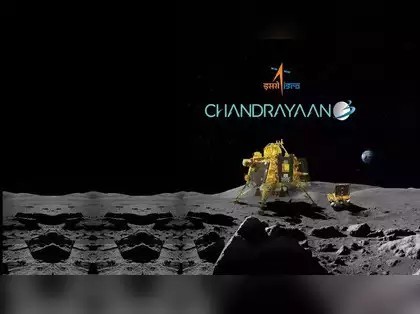Chandrayaan-3’s Lunar Map Reveals Moon’s Geological Secrets
Why in News?
Scientists have released the first detailed geological map of the Moon’s south pole using data from Chandrayaan-3’s Pragyan rover. The map confirms a global magma ocean, traces crater origins, and raises concerns over lunar contamination from future missions.
Significance of the Lunar Map:
- Astronomers have created the first-ever detailed geological map of the Moon’s south pole, where India’s Chandrayaan-3 lander, Vikram, touched down on August 23, 2023.
- The map, developed by PRL Ahmedabad, Panjab University, and ISRO’s Laboratory for Electro-Optics Systems, is expected to offer insights into the Moon’s origin and evolution.
- Data was collected by the Pragyan rover, which studied the chemical composition of the lunar regolith (loose rock and dust covering the surface).
Confirming the Moon’s Magma Ocean
- Findings confirm the Moon once had a global underground magma ocean, a theory previously suggested by missions like Apollo, Luna, and Chang’e.
- Chandrayaan-3’s Alpha Particle X-ray Spectrometer detected traces of magma beneath the landing site, proving the lava extended across the Moon.
- The map reveals an undulating landscape of highlands and plains, with debris traced back to the Schomberger crater.
- Scientists estimate the landing region to be 7 billion years old, aligning with the early evolution of life on Earth.
Implications and Concerns
- Lunar craters, including the South Pole-Aitken Basin, are key to understanding planetary history as they remain unchanged for millennia.
- Increasing human activities and space missions may disturb the Moon’s regolith and its thin exosphere.
- Scientists warn that lunar waste and spacecraft exhaust could contaminate ice reserves, impacting future exploration and resource extraction.
About Chandrayaan-3 Mission:
- Launch & Rocket: Launched on July 14, 2023, using LVM3, a three-stage rocket capable of placing payloads in Geosynchronous Transfer Orbit (GTO).
- Mission Goals: Soft landing, lunar surface exploration, and in-situ scientific experiments.
- Modules: Propulsion Module (2148 kg) and Lander Module (1752 kg, including 26 kg Rover).
- Key Discoveries: Confirmed a global magma ocean and mapped lunar craters.
- Enhancements Over Chandrayaan-2: Failure-based design, larger landing area, extra fuel, robust lander, fewer thrusters, sturdier legs, and additional solar panels.




